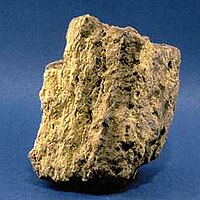
Photo from wikipedia
Abstract The Meso-Cenozoic Yili Basin in northwestern China hosts important uranium and coal resources. The uranium deposits are mainly hosted by sandstones and are characterized by clay and carbonate alterations… Click to show full abstract
Abstract The Meso-Cenozoic Yili Basin in northwestern China hosts important uranium and coal resources. The uranium deposits are mainly hosted by sandstones and are characterized by clay and carbonate alterations within and surrounding the orebodies. H-O-C isotopes of clay minerals and carbonate cement in the different alteration zones of the uranium deposits in the southern margin of the Yili Basin are summarized to examine the mechanisms of uranium mineralization. The alteration zones associated with the uranium mineralization include an intensely oxidized zone, a weakly oxidized zone, a transitional (mineralization) zone, and a reduced zone. The δD and δ18O values of the parent fluids calculated from clay minerals from the different alteration zones show a linear trend that intersects the global meteoric line at a point with a δ18OV-SMOW of ca. −5‰ and a δDV-SMOW of ca. −30‰, which coincide with the upper end of the δD – δ18O trend (along the meteoric line) of formation waters in the basin, suggesting that the uranium mineralizing fluid was of meteoric origin. The general trends of decreasing δD and δ13C and increasing δ18O from the intensely oxidized zone to the reduced zone, together with the fact that calculated δDV-SMOW values of the mineralizing fluids are lower than the original meteoric fluid, and that the δ13C values of the calcite cement overlap with those of organic matter in sedimentary rocks, suggest that hydrocarbons were involved in uranium mineralization. The hydrocarbons may have been important reducing agents causing precipitation of uranium minerals. The hydrogen ion released from oxidation of the hydrocarbons may have been buffered by the formation of clay minerals, which favors co-development of clay alteration and calcite cement. Deviation of H-O-C isotopes from the general variation trends as expected from the above redox mechanism likely resulted from the dynamic nature of the redox front, which changed its position in response to hydrodynamic balance between a downward flow of uranium-bearing, oxidizing fluid and an upward flow of reductants-bearing, reducing fluid from the lower part of the basin.
Journal Title: Ore Geology Reviews
Year Published: 2019
Link to full text (if available)
Share on Social Media: Sign Up to like & get
recommendations!